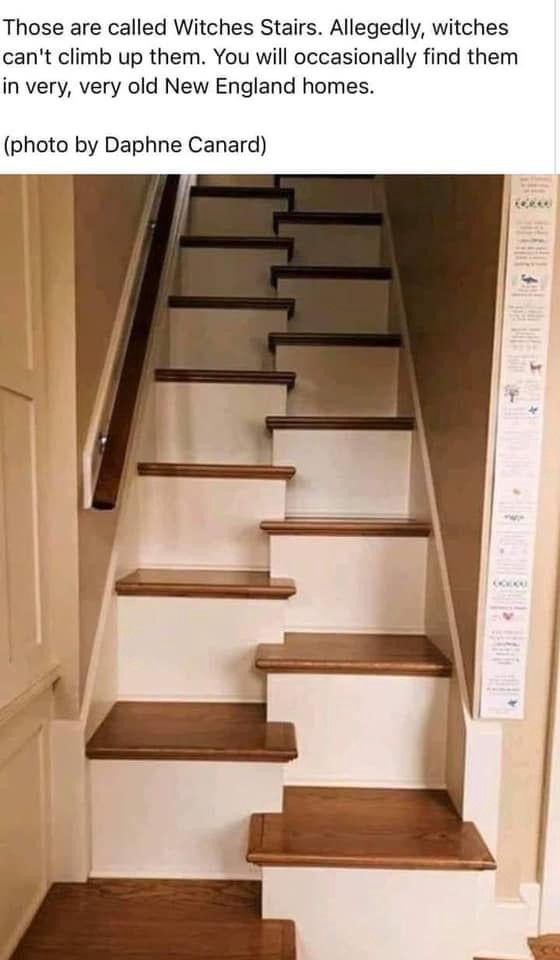Witches Stairs? Do They Exist?

Fact or social media urban legend?

My older children, my husband, and I finished WandaVision. If you are a Marvel fan, I definitely recommend the series. It was really well done with a bit of a twist or two.
If you know the story of Wanda Maximoff, she is also known as the Scarlet Witch in the Marvel series. No spoilers, but there is a scene that is similar to the Salem Witch Trials. A witch is on trial, but not be the townspeople, but by other witches which made me think of a recent social media post regarding “witches stairs.” Have you seen the post?

There are New England houses that the stairs that lead to the attic are so narrow and steep that each step on the stair case is half the length of a typical step. The stair case is uneven and staggered so that a person has to walk with a foot on each step. It was designed to save space and make the trips up and down less dangerous.
They are also called alternating tread stairs and are used when space is an issue. They usually lead up to only one room or to the attic.
However, there is an urban legend that a witch descending from the attic would have trouble because “witches can’t see their feet.” Have you ever heard of that before? I’ve heard of the swimming test and the witch’s mark, but never have I heard that witches can’t see their feet.
During the time of the Salem witch trials, a swimming test would be used , the accused would be stripped to their undergarments and have a rope tied around their waist. If the person sank, she wasn’t a witch and she would be pulled out of the water. If she floated above the water, she was a witch. However, more often than not, the accused witches ended up drowning, proving they weren’t witches, but too late to save them.
There was also the “witches mark.” It was usually a blemish, mole, or scar, but would be used to accuse someone of being a witch. Oft times they would try to remove the mark themselves, only furthering the suspicion that they were indeed witches. If you’ve ever read the Outlander series by Diana Gabaldon, when the main character is transported to the past, her polio vaccination scar was considered a witch’s mark.
But witches unable to see their feet? I’ve never heard that one identifying characteristic. Have you?
The rumor floating around social media about these unusual staircases is that these alternating tread staircases are called Witches Stairs. I looked around to see if this true, because 1) How fascinating and 2) Is it really true?
For the most part, there is little historical corroboration that there were ever a thing called witches stairs. It appears the caption, “witches stairs” that accompany the unusual alternate tread design is more fiction that fact.
However, while the theory behind witches stairs cannot be historically corroborated as being an actual “thing,” I did find evidence of a house in Brattleboro, Vermont owned by Deacon John Holbrook with a description of this unusual characteristic: “A sizable attic is located over the main house, reached by a very unusual ‘witches’ stair.” According to the National Register, the house was built in 1825 by a local Vermont carpenter, Nathaniel Bliss.
So while there is not other evidence that these stairs were ever actually called witches stairs, the idea behind it is fascinating.
After watching WandaVision, I doubt a set of alternating treads would hinder Wanda Maximoff, though if you notice, her house has the traditional staircase…draw your own conclusions.
What do you think? Have you ever heard of the witches staircase? What do you think of this distinct characteristic in New England homes?



